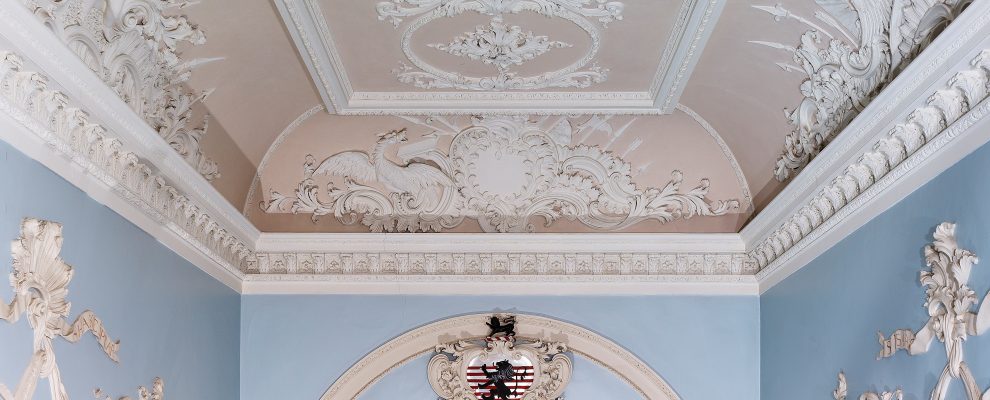When Viscount Fairfax commissioned a new decorative scheme for the fine townhouse he had bought for his daughter on Castlegate in York, he spared no expense in making these sumptuous interiors the height of style and fashion. You can see the results throughout Fairfax House today, in the lavish carved timberwork, elegant ironwork, and perhaps most of all in the elaborate plasterwork that decorates the main entertaining rooms and the Great Staircase.
The Great Staircase, the focal point of the house, is an exquisite work of Georgian decorative art. John Carr’s architectural genius combines with ironwork by Maurice Tobin and plasterwork by Giuseppe Cortese and James Henderson to celebrate the wealth, taste and status of the Fairfaxes as members of York’s social elite. The decoration embodies references to patriotic themes relevant to the Seven Years War (1756-63), which was in its final stages as the house was being completed – and on a more personal level it may be possible to find, concealed in the plasterwork, coded evidence of the Fairfaxes’ Catholic and Jacobite allegiances.
The oak leaf was a key Jacobite symbol, being associated with the Stuarts through the story of the ‘Royal Oak’, the tree in which King Charles II had hidden after the Royalist defeat at the Battle of Worcester in 1651. For the Jacobites the symbol of the flourishing oak tree also embodied the hope of a newly flourishing realm under a restored Stuart crown. Oak leaves are present in the Great Staircase plasterwork, incorporated into several of the banners that flutter among the weaponry of war. Among those weapons it is noticeable that one lance has its head shaped into a fleur-de-lis, a stylised form of lily associated with the Virgin Mary and thus a strongly Catholic symbol.
There are roses in the plasterwork decoration throughout the house, and while caution must be used in interpreting them too narrowly given that roses were part of the standard vocabulary of classical architectural ornament, it may well be that the many roses in the staircase plasterwork do make reference to the Jacobite white rose emblem. Roses are also present in the staircase ironwork, as are three rosebuds in the landing balustrade: these unusual features may refer to the unfulfilled potential of the Old Pretender and his two sons, the Princes Charles and Henry. Another symbol favoured by the Jacobites is the heart, and a prominent feature of the plasterwork is the shield bearing two hearts, supported by a putto holding aloft a flaming torch which perhaps symbolises allegiance to the cause of truth, whether conceived in religious or political terms.
It is impossible to arrive at a definitive interpretation of the Great Staircase’s complex, allusive and ambiguous decorative scheme. Two hundred and fifty years after its creation it continues to defy the unravelling of its secrets.

Source: In the Name of the Rose: The Jacobite Rebellions, Symbolism and Allegiance (Fairfax House, 2013)
